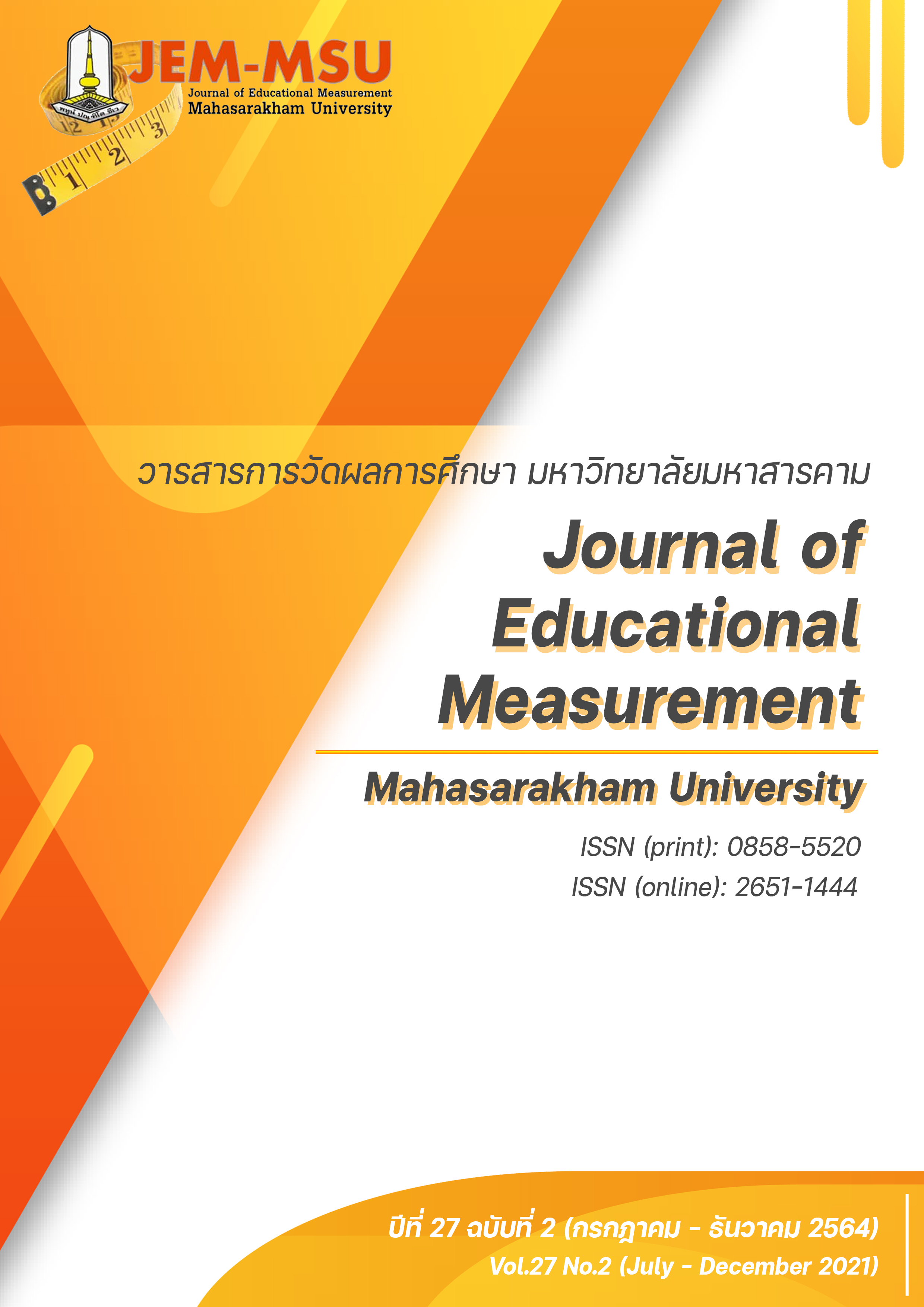Comparison of Quality of Holistic and Analytic Scoring Rubrics in Evaluation of Higher Secondary School Science Projects
Main Article Content
Abstract
The purpose of this research was to study the development of the project for the Primary School Find the quality of science project scoring criteria that have different scoring patterns by using multi-component of Rasch model and compare the quality of the science project scoring criteria that have different scoring patterns. The samples from a specific selection they were 8 science teachers and teacher who used to be a judge for a science project. The research instruments were holistic science project scoring criteria (Holistic Rubric) and scoring criteria for modular science projects (Analytic Rubric). Using multi-component of Rasch (MFRM) model for analysis and considered were reliability of separation index classified by both types of assessments rater leniency/ severity of science teacher, separation reliability of science teacher and students
Result of the research were rater agreement index – RAI of scoring criteria for modular science projects (RAI=0.873) and holistic classification criteria (RAI=0.865), so that criteria for scoring of both science projects has got reliability make the science teacher can be assessed at a high level. Consider the suitability of the appraiser; it was found that the science teacher can be suitability of the appraiser (INFIT and OUTFIT have between 0.6 – 1.4). The Measure all of the science teacher have strict characteristics is upper +1.00 everybody. The analysis of both analytic and holistic of project science by using multi-component of Rasch model, it was found that the science teacher using the component evaluation analytic form has got INFIT = 0.69 and OUTFIT = 0.66. Using the component evaluation holistic form has got INFIT = 1.82 and OUTFIT = 1.92. So that analytic science project assessment form is can be conformed more than holistic science project assessment form (Acceptable value is 0.6 – 1.4 Liancre,1994 )
Article Details
The content and information contained in the published article in the Journal of Educational Measurement Mahasarakham University represent the opinions and responsibilities of the authors directly. The editorial board of the journal is not necessarily in agreement with or responsible for any of the content.
The articles, data, content, images, etc. that have been published in the Journal of Educational Measurement Mahasarakham University are copyrighted by the journal. If any individual or organization wishes to reproduce or perform any actions involving the entirety or any part of the content, they must obtain written permission from the Journal of Educational Measurement Mahasarakham University.
References
กนิษฐา สวยสด. (2554). การเปรียบเทียบความเที่ยงและความเป็นปรนัยของการตรวจให้คะแนนผลงาน โดยใช้กฎเกณฑ์การให้คะแนนและไม่ใช้กฎเกณฑ์การให้คะแนน. ปริญญาครุศาสตรมหาบัณฑิต สาขาวิชาการวัดประเมิน และวิจัยทางการศึกษา, มหาวิทยาลัยราชภัฎลำปาง.
จันทร์ฉาย สุวลัย. (2552). การเปรียบเทียบความเที่ยงของการประเมินผลงานโดยใช้กฎเกณฑ์การให้คะแนน ที่นักเรียนร่วมสร้างกับกฎเกณฑ์การให้คะแนนที่ครูสร้าง. ปริญญาครุศาสตรมหาบัณฑิต สาขาวิชาการวัดประเมิน และวิจัยทางการศึกษา, มหาวิทยาลัยราชภัฏลำปาง.
ไซลัน สาและ. (ม.ป.ป.). เกณฑ์การให้คะแนน. ค้นเมื่อ 19 สิงหาคม 2560, สืบค้นจาก http://www.ded.edu.kps.ku.ac.th
น้ำผึ้ง อินทะเนตร. (2554). การศึกษาคุณลักษณะของคะแนนแบบทดสอบปลายเปิดวิชาคณิตศาสตร์เมื่อจำนวนผู้ตรวจและรูปแบบการตรวจให้คะแนนต่างกัน โดยใช้โมเดลการสรุปอ้างอิงและโมเดลหลายองค์ประกอบของราส์ช. ปริญญาการศึกษาดุษฎีบัณฑิต สาขาวิชาการทดสอบและวัดผลการศึกษา บัณฑิตวิทยาลัย มหาวิทยาลัยศรีนครินทรวิโรฒ.
บุษวรรษ์ แสนปลื้ม. (2556). การใช้วิธีการตรวจคุณลักษณะ และสัดส่วนจำนวนผู้ตรวจให้คะแนนที่มีผลต่อความเที่ยงตรงของการวัดความสามารถในการเขียนของนักเรียนชั้นประถมศึกษาปีที่ 3. ปริญญาการศึกษาดุษฎีบัณฑิต สาขาวิชาการทดสอบและวัดผลการศึกษาบัณฑิตวิทยาลัย มหาวิทยาลัยศรีนครินทรวิโรฒ.
ประทีป กาลเขว้า. (2559). การพัฒนารูปแบบการประเมินทักษะการปฏิบัติทางวิชาชีพ ด้านการจัดการอนามัยสิ่งแวดล้อม : การตรวจสอบคุณภาพเกณฑ์การให้คะแนนโดยใช้โมเดลหลายองค์ประกอบของราส์ช และประยุกต์ใช้กรอบแนวคิดการประเมินศูนย์ควบคุมและป้องกันโรคแห่งสหรัฐอเมริกา. วิทยานิพนธ์ปริญญาปรัชญาดุษฎีบัณฑิต สาขาวิชาการวัดและประเมินผลทางการศึกษา บัณฑิตวิทยาลัย มหาวิทยาลัยขอนแก่น.
ศุภกิจ ศรีจองแสง. (2553). การสร้างและพัฒนาเกณฑ์ประเมินการอ่าน คิดวิเคราะห์และเขียนของนักเรียนช่วงชั้นที่ 4 สังกัดสำนักงานเขตพื้นที่การศึกษาเชียงราย เขต 2. วิทยานิพนธ์ครุศาสตรมหาบบัณฑิต สาขาการวิจัยและประเมินผลการศึกษา มหาวิทยาลัยราชภัฎเชียงราย.
ศูนย์วิทยาศาสตร์เพื่อการศึกษา. (2559). เกณฑ์การประกวดโครงงานวิทยาศาสตร์ ประจำปีงบประมาณ 2559. กรุงเทพฯ: ศูนย์วิทยาศาสตร์เพื่อการศึกษา.
สถาบันส่งเสริมการสอนวิทยาศาสตร์และเทคโนโลยี. (2549) คู่มือวัดผลประเมินผลวิทยาศาสตร์ สสวท. . กรุงเทพฯ: โรงพิมพ์คุรุสภาลาดพร้าว.
สุวิมล ติรกานันท์. (2551). สถิติและการวิจัยเบื้องต้นทางการศึกษา. กรุงเทพฯ : สำนักพิมพ์มหาวิทยาลัยรามคำแหง.
Chi, Eunlim. (2001). Comparison Holistic and Analytic Scoring foe Performance Assessment with Many – Facet Rasch Model. Journal of Applied Measurement. 2(4):379-388.
Linacre, John M.; et al. (1994). Measurement with Judges : Many – Faceted Conjoint Measurement. International Journal Research. 21(6). 569-577.
Stenmark, Jean K. (1991). Mathematics Assessment : Myths, Models, Good Questions, and Practical Suggestions. 6th ed. Reston, Virginia : National Council of Teachers of Mathematics.


